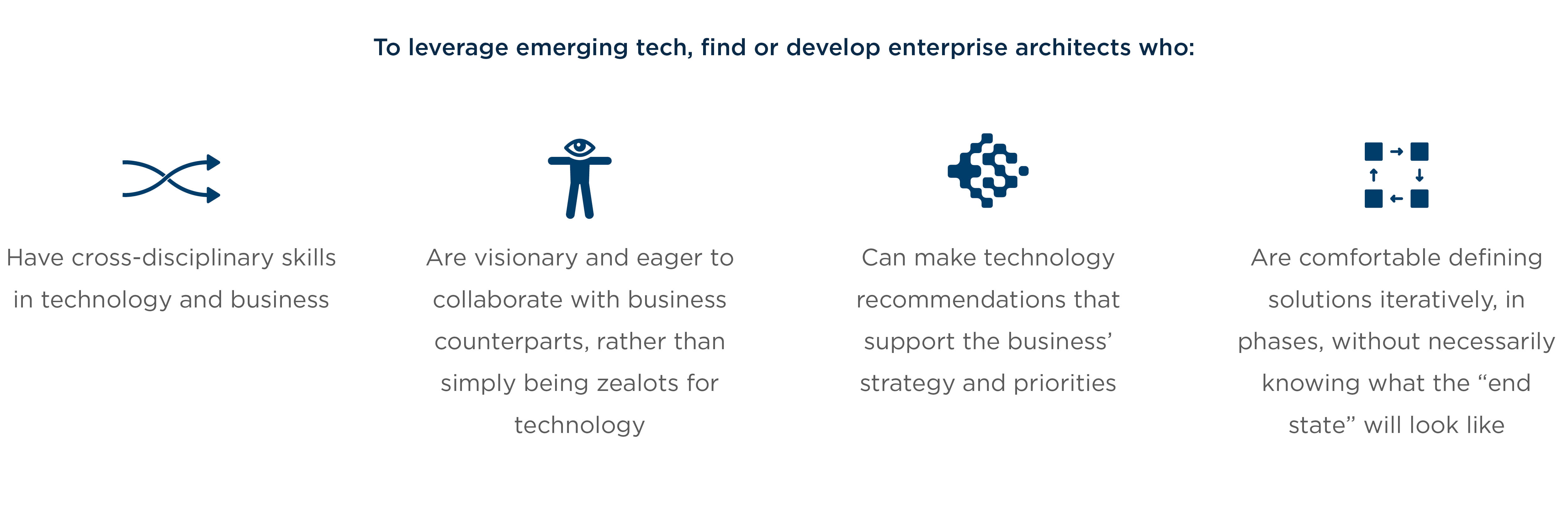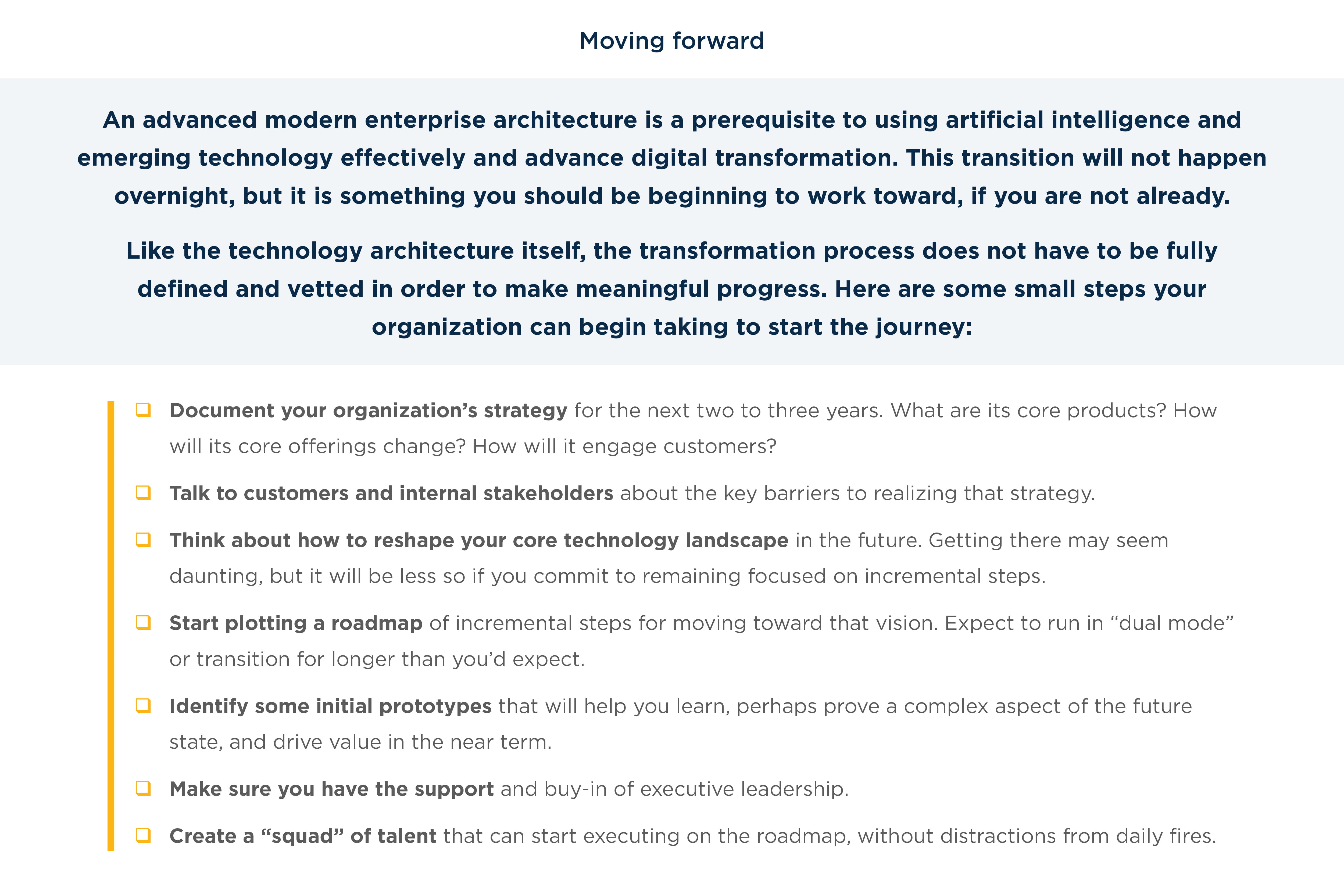
September 2019 | Point of View
Modern enterprise architecture: Five things you must do right to help your organization benefit from emerging technologies
The historical approach to enterprise architecture doesn’t work in the digital age. Businesses must adopt a modern architecture that is better suited to handle rapidly evolving business needs.
-
Before companies can take advantage of emerging technology, they must change their approach to enterprise architecture. This requires more than technology changes. It requires transformation of enterprise architecture skills, organizational structure, culture, and expectations—and, indeed, the very role and stature of enterprise architects in the business.
-
The historical approach to enterprise architecture doesn’t work in the digital age. While most organizations understand that building software has become more agile, they still look at architecture as a static planning exercise. Instead, begin moving to a modern architecture that is better suited to handle rapidly evolving business needs.
-
From our experience working with organizations to enable emerging technologies, we have found it beneficial to focus on five areas: the right level of “voice” and leadership in the organization, the right organizational structure, the right talent, the right culture, and the right roadmap.
-
An advanced modern enterprise architecture is a prerequisite to using artificial intelligence and emerging technology effectively and implementing a digital strategy that your business is demanding. This transition will not happen overnight, but it is something you should be beginning to work toward, if you are not already.
Introduction
Many businesses are demanding new digital technology and other emerging technology tools, including artificial intelligence, to keep pace with evolving markets and consumer expectations. These demands are straining technology organizations that try to implement new technology within existing enterprise architecture. In fact, the old-school approach to enterprise architecture hinders the ability to use emerging technologies to improve business agility, speed, and innovation.
Before companies can take advantage of emerging technology, they must change their approach to enterprise architecture. This requires more than technology changes. It requires transformation of enterprise architecture skills, organizational structure, culture, and expectations—and, indeed, the very role and stature of enterprise architects in the business.
This paper offers a recipe for moving toward a modern enterprise architecture approach that will allow your business to take advantage of emerging technologies and tools that create new levels of productivity and business value.
Chapter 1: Emerging technology is here and ready. So, what is the problem?
To thrive in both up and down markets, companies across industries must adapt to the increased pace of business. They must be able to make decisions faster, respond to customers faster, and bring new products and capabilities to market faster. Speed of innovation, however, remains a significant barrier to growth and competitiveness.
In many organizations, the business is demanding emerging digital tools and technologies such as artificial intelligence, sometimes without a clear vision of exactly how they will apply them. One of the key factors hindering adoption is the continuing use of “old school” approaches to enterprise architecture. Today’s technology organizations simply aren’t built in a way that allows them to move quickly. Their technical foundation is monolithic and difficult to adapt. Accessing new data sources requires extensive, time-consuming work. Users need to be able to find a source of data in the moment they need it, with a day’s effort (or less) rather than an eight-month integration project.
The historical approach to enterprise architecture doesn’t work in the digital age. While most organizations understand that building software has become more agile, they still look at architecture as a static planning exercise. Instead, they need to begin moving to a modern architecture that is better suited to rapidly evolving business needs.
While most organizations understand that building software has become more agile, they still look at architecture as a static planning exercise. Instead, they need to begin moving to a modern architecture that is better suited to rapidly evolving business needs. ”
Chapter 2: What is modern enterprise architecture?
In the past, technology architects developed complex diagrams of how enterprise technologies fit together to run aspects of the business. The company then invested over time to roll out specific elements of the architecture to groups across the organization. The vision and design were generally static, changing little over time. As a result, companies organized teams around elements of the architecture. Today, those teams work in silos and make key decisions about data and applications in their remit. The result is a technical foundation that is very complicated and time-consuming to adapt in order to employ emerging technologies and access evolving and new data sources.
With modern enterprise architecture, the organization no longer has a rigid, inflexible technology blueprint. Rather, the architecture and technology are fluid and flexible, capable of incrementally adapting in weeks or months rather than several years. Development occurs in repetitive cycles rather than as a defined “process.”
More importantly, business vision and value creation are the impetus for all technical decisions, and the modern enterprise architect is an active participant in those discussions with the business. If the “technology du jour” as demanded by the business meets a business goal, modern architecture makes it easier for the organization to test and validate the opportunity. An enterprise architect who is involved in discussions with the business about entering a new market to test a new potential revenue stream can design ways to incrementally perform the test, and a modern architecture allows this addition to the system without impacting established areas of the business.
If the “technology de jour” as demanded by the business meets a business goal, modern architecture makes it easier for the organization to test and validate the opportunity. ”
At its 2019 Enterprise Architecture & Technology Innovation Summit, Gartner compares this to a cathedral and a bazaar. The cathedral is the product of old-school architecture: It is meticulously planned, takes many years to finish, and requires extensive effort to adapt. The bazaar, on the other hand, is an example of modern architecture: It has structure in that certain products exist in certain areas, but it is continuously evolving and growing to enable vendors to meet new customer demands. That can present a sense of chaos, but a technology organization that can find order in that chaos and harness it to execute a strategy can succeed in helping their business benefit and drive value from emerging technology.
The challenge is figuring out how to shift the foundation to one that supports the pace of today’s marketplace, without disrupting current business. Gartner emphasizes the need to have both foundational and vanguard enterprise architecture—that is, one discipline with two priorities that happen simultaneously. In other words, it continues to evolve like the bazaar, while still thriving as a market that provides what people came to buy.
Chapter 3: 5 essentials for modern enterprise architecture
From our experience working with organizations to enable emerging technologies, we have found it beneficial to focus on these five areas.
1. The right level of “voice” and leadership in the organization
If digital strategy is becoming the business strategy, then it isn’t out of line to start thinking of enterprise architecture as the new business architecture. In a recent survey of Gartner Research Circle Members, one in five respondents (21%) said enterprise architects are “leaders” in their organization’s evaluation of emerging technology, with responsibility for strategy and decisions. More than half (52%) said that enterprise architects are “collaborators” in evaluating emerging technology, while just 1% said the role of the enterprise architect is “implementer.”
This suggests that enterprise architecture needs a bigger voice in defining business strategy. Of course, that doesn’t mean reporting to the CEO—that is not practical.
But the chief information officer or chief digital officer often does report to the CEO, so that role must set the stage for amplifying the topic of enterprise architecture at the strategic level. Additionally, enterprise architects must begin to be involved in discussions with product owners and customers (or their business delegates). The right to participate in those discussions is far more important than the specifics of the reporting structure.
2. The right organizational structure
Organization structure (or lack thereof) is one of the biggest roadblocks to accelerating adoption of digital and artificial intelligence. Historically, application development, security, infrastructure, and analytics
all work in separate structures (“silos”), with their own development cycles. To advance the use of emerging technologies, they need to work together in a cross- discipline structure—and together on the same cycle without distraction from typical fires of the day.
Trying to orchestrate modern enterprise architecture within existing organization structures will not be successful. Rather, the organization must assemble new teams that are aligned with business leaders and/or product owners rather than with technology disciplines. Furthermore, these teams must work in different ways than EA professionals are used to working today. There are plenty of examples out there from which to learn. For example, Mastercard Labs establishes “squads” for turning incubation projects into commercialized products, with team members leaving their jobs for six months to work on the project.
Global bank ING recognized the need to support “intrapreneurs” in transitioning between roles, so it developed internal processes to protect employees who leave their roles to work on a squad project, grants squad members independence for making decisions, and celebrates successes across the company.
As Spotify faced the challenge of rapidly building an organizational structure that would enable it to scale and compete with Google and Amazon, it established squads, chapters, guilds, and tribes that operate with “minimum viable bureaucracy” and “balance high autonomy with high alignment.” It also set organizational design principles, called “Agile à la Spotify” that are printed on the walls of its office.
These are merely examples: There is no prescriptive, agile structure that can fit every organization. What is important, however, is that each future-state organization evolves from its current model to drive business outcomes at speed.
3. The right talent
If people are expected to work in different types of teams, then it also makes sense that the EA skillset will need to evolve. Enterprise architects of the past are good managers and controllers of technology, but they are used to working within very structured frameworks. Modern enterprise architecture requires creative personalities who are more open to and comfortable with change, uncertainty, and autonomy.
Gartner reports that EA skills are at an inflection point. Where in the past, required skills were predominantly technical, now half or more of the required EA skills are business related. In fact, according to research of 216 Gartner Research Circle Members, the top three enterprise architecture skills required for demonstrating high value in the innovation process are:
Technology skills ranked eighth, with just 16% of survey participants considering it to be among the top three skills required.
These qualities are rare but important. Your organization may need to go outside for them, but it also may be possible to find them inside the enterprise by looking for people known to be “innovators.”
4. The right culture
Just as the enterprise architect must be able to think and work differently, so, too, must the organization. To facilitate the move into a new market, introduce a new product, flex to changing demands, and/ or scale quickly, the organization must become more fluid and dynamic. It must be willing to allow autonomy, experimentation, and the ability to fail and then move on quickly. And, like the modern enterprise architect, it must be comfortable starting development without having the “perfect” design in mind.
The organization also needs to adopt a product- or customer-first mindset—one that enables it to envision desired outcomes and then work backward to understand what technology and people must to do to achieve those outcomes.
Finding people who think in these ways is one thing; changing the culture of the organization to accept these ways is quite a different matter. ING took the radical step of reorganizing over a weekend, firing all employees and requiring them to reapply for their jobs through the lens of the customer need they solved. While this is an extreme solution, it does illustrate the potential magnitude of the culture and mindset shift required.
The organization also must find a way to become immune to “hype cycles.” Many companies get caught up in chasing artificial intelligence because they believe the business must have it ASAP in order to be successful. But to be able to use artificial intelligence, the organization needs a more fluid architecture that can source data from many and evolving sources, as well as a culture and organization that can identify the right problems with it. Instead of focusing on the “what,” focus on the “why” and use that mindset to begin creating architecture that can get your organization there over time. This allows the business to begin trying artificial intelligence in niche areas where it adds value.
5. The right roadmap
Finally, the organization will need to rethink its traditional development timeline and instead generate a roadmap that delivers value in months rather than years. The roadmap should orchestrate the move from the old EA platform to new enterprise architecture in incremental steps over time. For example, a financial services company wants to establish new infrastructure for managing risk more dynamically—a process that will likely take several years. It breaks this into incremental steps:
It establishes the first service in the cloud within three months.
Then, it introduces a second cloud-based service two months later and aggregates the services to build a subset of reporting solutions—and so on.
This approach starts to pull key functions away from the legacy foundation in a bite-sized manner and provides “guiderails” for directing innovation.
When tourism conglomerate TUI embarked on digital transformation, rather than overhauling technology it began by focusing on customer experience—learning from customers what they want in a digital world and then using middleware interfaces to connect front- end applications with the legacy back end. Then, it divided the back end into “modular subsystems” and slowly replaced them, while establishing new front-end functionality. This allowed the organization to mature its enterprise architecture incrementally but quickly toward the future state, without a complete rewrite.
Conclusion
Our team works with clients to transform architecture to meet business needs. We can help you think through strategies for maximizing the value of existing infrastructure investments while improving your ability to use emerging technology to respond to change.



